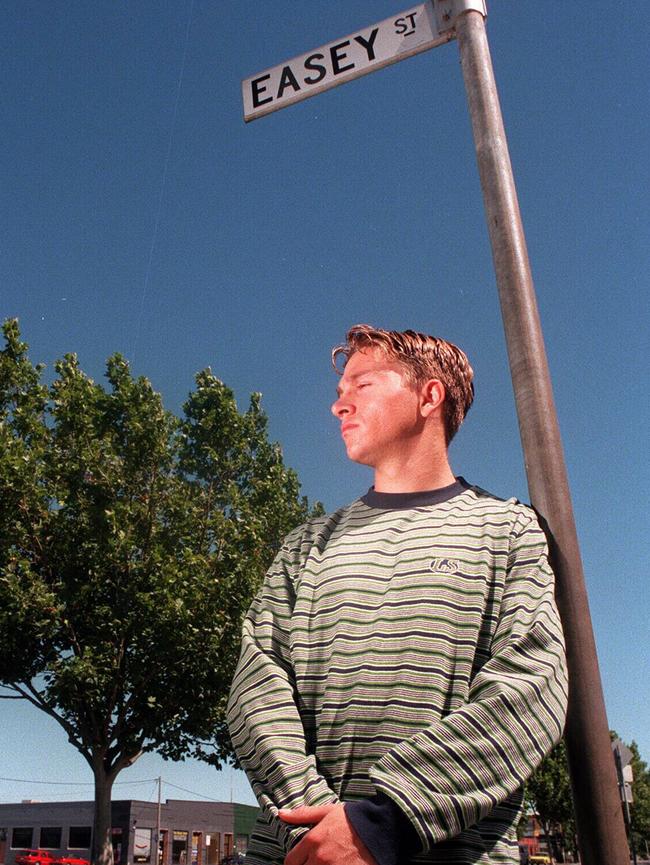No Easey answers 40 years after women slain
A TODDLER cowered in his cot as his mum and her friend were butchered nearby, in a horror kill spree that has baffled police for years. And there’s one suspect who can’t really be ruled out.
True Crime Scene
Don't miss out on the headlines from True Crime Scene. Followed categories will be added to My News.
HE’S out there somewhere, whoever butchered Suzanne Armstrong and Susan Bartlett while Suzanne’s toddler son cowered in his cot in their house in Easey St, Collingwood.
But is he alive?
It’s 40 years this month since the night of double murder that still haunts Melbourne — and at least that many potential suspects have died, whittling down a police checklist with more than 100 names on it.
As each anniversary looms, it becomes more likely the Easey St killer is dead. He must be between 60 and 80 years old, maybe older.
It’s tempting to assume a deranged and damaged man who would stab two young women dozens of times would lead a self-destructive life and die young.

But assumptions are risky, as Perth police found last month when they charged a quiet Telstra technician and hobby photographer over the 1990s Claremont murders — after years of treating an innocent public servant as the prime suspect.
It is wrong to say their Victorian counterparts in the 1970s leapt to conclusions then tried to prove them.
But it is hardly surprising that an apparently random killing spree like the one at Easey St hit the “too hard” basket.
In the pre-DNA era, if a murder was not an obvious “domestic”, it made investigation difficult — not because there were too few suspects but because there were too many.
The “two Sues”, former school mates from Benalla High, had travelled widely before renting together in Melbourne. They were popular and friendly and enjoyed meeting people.
Among the friends believed to have visited the house in the 10 weeks they lived there was a famous racing driver, a television cameraman, a legal figure, two shearers, a salesman — and a notorious former policeman who a veteran crime reporter always suspected.
The 40th anniversary of the crime has given the authorities a reason to announce a $1 million reward.
It’s a lot of money and so it should be, to entice someone to break the silence of a lifetime, or even voice a lingering suspicion.


The reward puts Easey St back in the news and better DNA testing techniques suggest a breakthrough might be more likely now — but it is more hope than plan.
It’s not the first time DNA has seemed to promise a silver bullet. In late 1998, after 22 years and endless false leads, two Melbourne detectives went to England to find one of a list of eight “good” suspects the squad had kept for years.
The detectives met their Scotland Yard counterparts and sat off a dole office in the seaside town of Margate in Kent. The suspect collected his dole and the London detectives collected him, casually asking for a blood sample to clear him in a local “routine inquiry”.
Back in Melbourne, the blood was tested to see if it matched DNA from semen found on Suzanne Armstrong’s body, and which police assumed belonged to the killer. It drew a blank. So did samples from seven other suspects. The list included a long-suffering shearer from country Victoria who had gone out with Suzanne Armstrong just weeks before the murders.
It also included a hard-living crime reporter who had spent the night of the murder — January 10, 1977 — in the neighbouring terrace house through the wall from No.147. And there was a salesman who had met Susan Bartlett the week before.
By chance, both the shearer and the salesman had visited the house in the two days after the murders without discovering the bodies in the bedroom at the front of the house.
Luckily, each man had come with someone else who could swear they’d innocently dropped in. The salesman had climbed through the window of Susan Bartlett’s empty bedroom and jotted down the telephone number without realising the bodies were just up the unlit hall. The shearer (and his brother) came in the unlocked back door but decided it would be bad manners to walk up the hall.


It wasn’t until the Thursday that the neighbour, Ilona Stevens, saw a note she had left on the front door (about finding Suzanne’s dog being loose in the street) had not been touched in two days. Ilona and her housemate investigated, heard little Greg whimpering, and found a scene they would never forget.
Detectives were baffled that day and have been ever since. They now have a list of 41 dead men and 90 live ones to eliminate through new DNA tests. For decades, police have assumed that semen found with Suzanne Armstrong’s body must be the killer’s. It’s a natural assumption, easy to accept but hard to prove.
Two former homicide detectives this week conceded it is possible the original sample could be from an innocent man — a casual lover who visited Suzanne Armstrong earlier in the evening she died. But another investigator who saw the scene believes otherwise.
Several suspects have been eliminated from the investigation. One of them was a Collingwood criminal called Neil Rowland Bugg, a psychopath with no teeth and a terrible temper.
A few years before he died in 2013, standover man Mark “Chopper” Read mentioned knowing Bugg in jail. Prisoners were wary of the volatile “Buggsy”.
They avoided waking him up because he would leap up and attack them. Most prisoners believed Bugg had done the Easey St murders — and had been overlooked because of being arrested for another murder around the same time: supposedly a case of hiding in plain sight, Read claimed.
Read’s story fitted some intriguing facts. At 4am on January 1, 1977, a young Collingwood constable called Ron Iddles — later a gun homicide investigator — was first to a strange scene in Wellington St. A station wagon had run off the road because a back-seat passenger had cut the driver’s throat with a broken bottle.

The dead man was Peter Phillip Fergeus, a labourer from Epping. The vigilant Iddles noticed blood on an onlooker’s feet and told detectives. It was Bugg, alias “Lester Hargreaves”.
Bugg, 25, was interviewed but released before the Easey St murders of January 10. He was arrested in Brisbane two weeks later, on January 23, and extradited to face charges of murdering Fergeus. It’s possible but unlikely he was asked to prove he wasn’t in Melbourne on the night of the Easey St murders.
Read’s story was passed to detectives about 2008. Investigators set up a discreet operation to obtain Bugg’s DNA to check against the Easey St sample. Like the others, it did not match.
So much for science. Meanwhile, there’s the Melway. The spot where Bugg killed Fergeus in a senseless frenzy is around the corner, about 500m from the Easey St house where two women died in a senseless frenzy. And his home address was not much further away, a 10-minute walk.
But a detective who worked on the case believes it was clear Suzanne Armstrong had not been alarmed by a stranger in her bedroom. She had neatly folded back the sheet and put her book, Roald Dahl’s Switch B---h, face down on the bed, which suggests she knew the visitor.
The detective agrees with the late Tom Prior, who wrote a book about the case, They Trusted Men, in the 1990s. Prior gave a disgraced former policeman the alias “Jones”.
Jones had been dismissed from the force for making sexual advances to female motorists, had been to the house before, was working close by and gave contradictory accounts of his movements during the week of the murders. But maybe he still had friends in high enough places.



